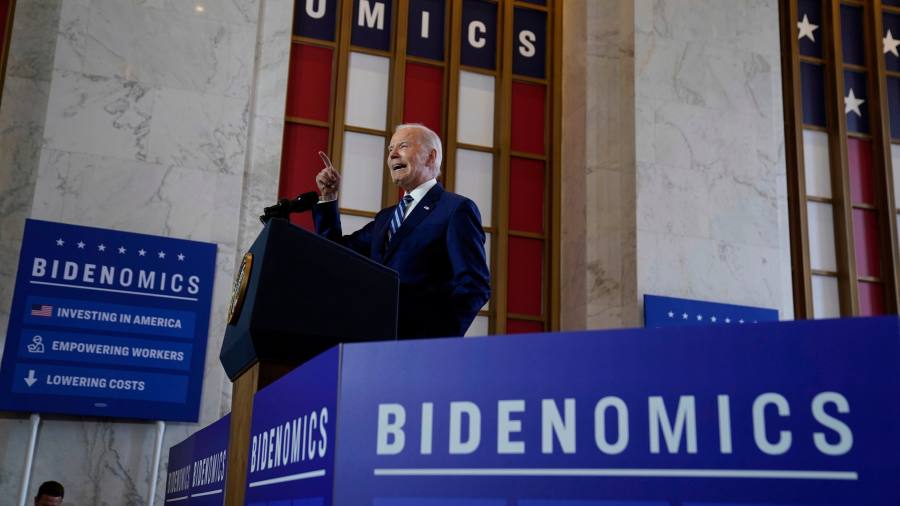
This article is an on-site version of our Energy Source newsletter. Sign up here to get the newsletter sent straight to your inbox every Tuesday and Thursday
Welcome back.
Oil prices edged up again yesterday — but barely. Brent settled at $76.65 a barrel, a 0.4 per cent rise on the day for a 2 per cent gain this week — hardly the uptick Opec+ had hoped for when Russia and Saudi Arabia announced more supply cuts on Monday.
As David wrote on Tuesday, for all of the group’s efforts, the market doesn’t seem particularly convinced that there’s going to be a shortage of oil anytime soon.
On to today’s Energy Source, where America’s energy transition is back in focus.
Yesterday, the US greenlit the country’s third offshore wind farm; today President Joe Biden hits a South Carolina solar parts plant to tout the surge in clean energy jobs that has flowed from the landmark Inflation Reduction Act.
Yet despite the steady drumbeat of clean energy projects and job announcements emanating from the White House, concerns are increasing about the fallout beyond the country’s shores.
In our main item, Amanda digs into fears that the unabashedly ‘made in America’ push of the IRA could harm developing nations as it hoovers up clean energy investments.
That is less of an immediate concern for the president as he gears up for a re-election campaign. And as Data Drill shows, domestically, green jobs numbers continue to rise.
Thanks for reading — Myles
The US green push risks ‘slowing’ the transition elsewhere
Almost a year since its passage, the impact of the IRA is hard to overstate.
The $369bn package is a game-changer for US climate progress, after years as a laggard; it has reinvigorated the country’s industrial base, previously battered by globalisation; and it has sparked a scramble by rich allies to match its largesse with subsidy packages of their own.
But for all its benefits, analysts warn developing countries are being left in its wake.
“The key concern . . . is how do you attract investment when it appears that low-carbon investment in the United States is so financially attractive?” said Joseph Majkut, director of the energy security and climate change programme at the Center for Strategic and International Studies.
When Biden passed the IRA last August, he ushered the world into a new era of carrots-based climate policy. The landmark climate law includes hundreds of billions in tax credits for clean energy development and is a prime example of “Bidenomics”, the latest buzzword for the president’s economic philosophy of using government funding to spur private investment and growth.
Some other countries have followed suit. The EU, Canada, and Australia have sought to come up with their own competitive subsidies as they lash out at the US over “protectionism” and cautioned against a “subsidy war”.
But as richer countries look to prevent an exodus of businesses to the US, many countries in the developing world lack the financial means to compete with the US’s economic might.
Clean energy investments have been stalling in developing countries even before the passage of western subsidies, making up less than 10 per cent of global investment in 2021, according to BloombergNEF.
David Scaysbrook, co-founder of Quinbrook Infrastructure Partners, an investment manager, said attempts by even wealthy western countries to compete with IRA tax credits have been “drops in the bucket”.
“There’s not another country that can get even close to that in terms of the financial horsepower,” said Scaysbrook, adding that the US is its “number one” investment destination.
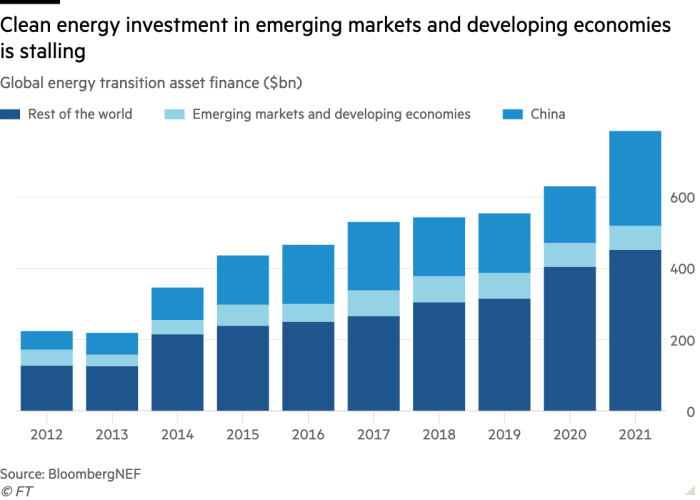
‘We will all be poisoned at the same level’
As well as the immediate draw from the subsidies, the protectionist leanings of the bill (bonuses for developers using US-made materials and requirements for manufacturing to take place domestically or in North America) have created an uneven playing field, some argue, undermining global trade.
“More efforts to protect your producers lead to responses, which just increases barriers to trade and the cost for trade,” said Albert Park, chief economist at the Asian Development Bank. “We just think all of that is terrible for the world. You’re going to slow the green transition.”
Underlying the IRA’s design is the US intention to move supply chains away from China, the world’s powerhouse for clean energy technologies, and revitalise industrial heartlands at home.
David Victor, a senior fellow at Brookings, warned this “green nationalism” among western nations will be dangerous for the energy transition and “Balkanise” global markets.
“The rest of the world is concerned that the United States can’t credibly distinguish between its China problems and its pro-America goals,” Victor said. “There’s huge concern that Americans are going to be so obsessed about making American jobs that they’re going to erode the benefits of global trade.”
The sheer scale of the IRA also comes amid more calls from the global south for wealthy nations to meet their commitments for climate finance.
“We need to invest more in developing countries,” said Kıvanç Zaimler, energy group president of Sabanci Holding, a Turkish industrial conglomerate. “If the US is clean by 2050 and most of the world is still dirty, we will all be poisoned at the same level.”
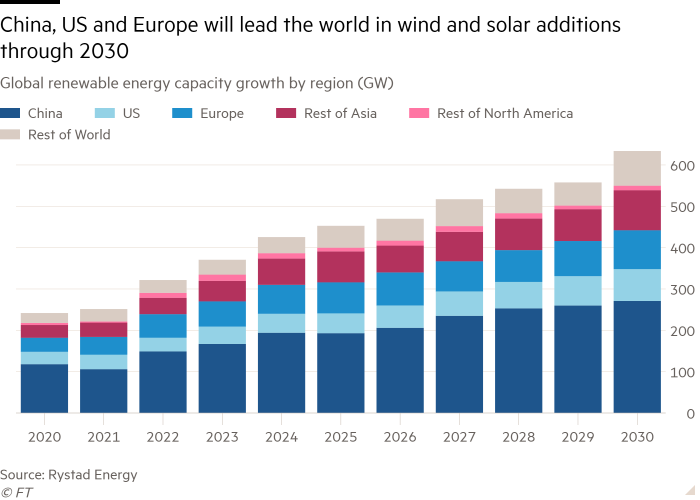
While foreign aid was never a priority for the IRA, there are provisions for the rest of the world to take advantage of its economic opportunity. Its clean vehicle tax credit, for example, allows raw inputs to be sourced from abroad, so long as the country has a trade agreement with the US.
Driving down costs
Even though many of the manufacturing tax credits require domestic siting, the massive scale up of clean tech could help reduce their costs for global adoption.
“It is the responsibility of the US to commercialise these technologies and to make them cost effective for countries around the world to be able to deploy,” Jigar Shah, director of the US Department of Energy’s loan programmes office, told Energy Source in April.
Kimberly Clausing, a senior fellow at the Peterson Institute for International Economics, said: “It’s partly a question of whether you want to be the producer, in which case that subsidy is going to put you at a disadvantage. But if you’re just consuming these products, the subsidy part is OK.”
That may be so. But in the near-term, insisting on domestic manufacturing will drive up the cost of going green.
“The IRA is only a globally positive thing if what it does is drive down the cost of green tech,” said Charles Kenny, a senior fellow at the Center for Global Development.
“The more that you burden the IRA with requirements that massively increase the cost of the final product by bringing manufacturing to the United States, the less it will have its climate impact. The more it will be bad for developing countries.” (Amanda Chu)
Data Drill
Still, whatever the concerns about the international impact, the domestic green jobs boom is continuing apace.
The US added 114,000 clean energy jobs last year, according to a new report from the energy department. That marks a 3.9 per cent climb from 2021.
California led the charge in absolute numbers, with 13,293 new jobs. The Rustbelt was also among the top states for clean energy job creation, with West Virginia adding 6,975 jobs — a nearly 20 per cent increase year over year.
US energy secretary Jennifer Granholm boasted that the numbers showed “the clean energy transition is accelerating, with job growth across every pocket of America”.
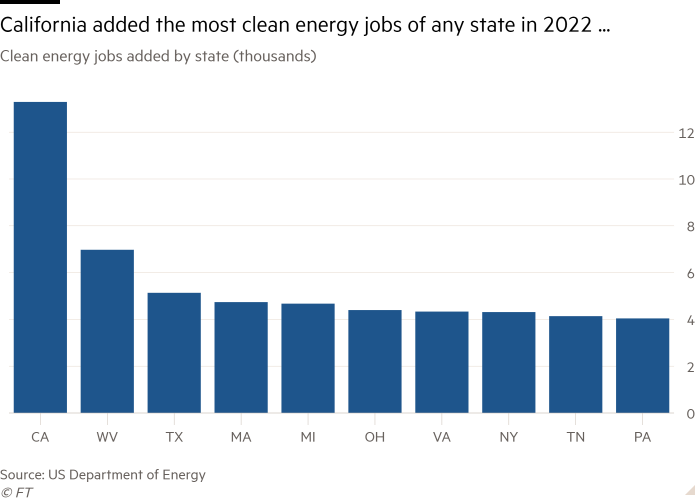
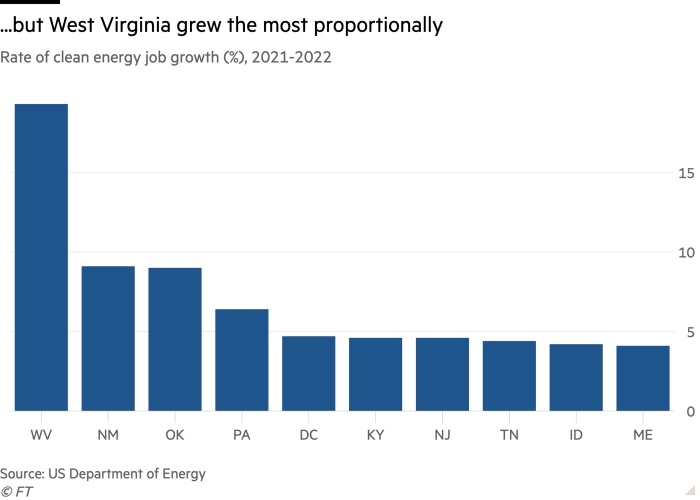
(Miguel Johnson)
Power Points
Energy Source is written and edited by Derek Brower, Myles McCormick, Amanda Chu and Emily Goldberg. Reach us at [email protected] and follow us on Twitter at @FTEnergy. Catch up on past editions of the newsletter here.
Recommended newsletters for you
Moral Money — Our unmissable newsletter on socially responsible business, sustainable finance and more. Sign up here
The Climate Graphic: Explained — Understanding the most important climate data of the week. Sign up here